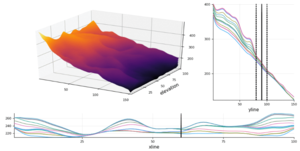2018 CSDMS meeting-043
Log in (or create account for non-CSDMS members)
Forgot username? Search or email:CSDMSweb@colorado.edu
Browse abstracts
ImageQuilting.jl: A code for generating 3D stratigraphy from data collected in flume experiments
Surface processes are constantly reworking the landscape of our planet with perhaps the most diverse and beautiful patterns of sediment displacement known to humanity. Capturing this diversity is important for advancing our knowledge of systems, and for sustainable exploitation of natural resources by future generations. From a modeler's perspective, great diversity comes with great uncertainty. Although it is understandably very hard to quantify uncertainty about geological events that happened many years ago, we argue that modeling this uncertainty explicitly is crucial to improve our understanding of subsurface heterogeneity, as stratigraphy is direct function of surface processes. In this modeling work (and code), we aim to build realistic stratigraphic models that are constrained to local data (e.g. from wells, or geophysics) and that are, at the same time, subject to surface processes reflected in flume records. Experiments have improved tremendously in recent years, and the amount of data that they generate is posing new challenges to the surface processes community, who is asking more often the question "How do we make use of all this?" Traditional models based on differential equations and constitutive laws are not flexible enough to digest this information, nor were they created with this purpose. The community faces this limitation where the models cannot be conditioned on experiments, and even after exhaustive manual calibration of unobserved input parameters, these models often show poor predictive power. Our choice of inverse modeling and (geo)statistics (a.k.a. data science) was thus made knowing that these disciplines can provide the community with what we need: the ability to condition models of stratigraphy to measurements taken on a flume tank.

